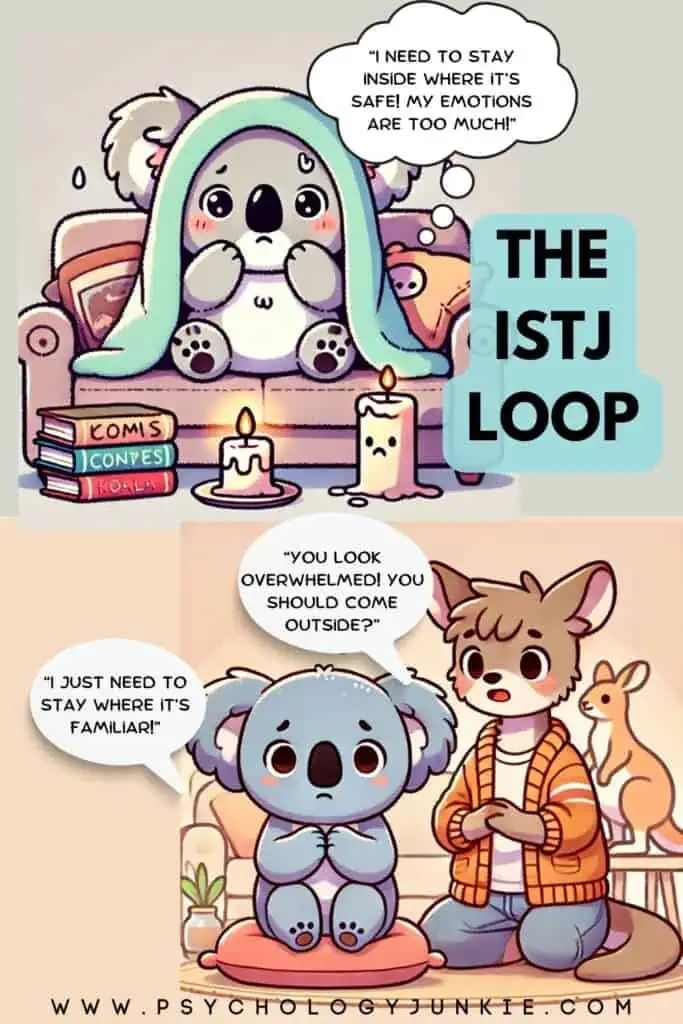The ISTJ Si-Fi Loop: When Routine Becomes a Rut
Do you ever find yourself going through the motions, doing what’s familiar, but feeling less and less motivated? As an ISTJ, your natural ability to organize, plan, and execute is pretty impressive. But sometimes, even the most reliable superpower can backfire. This can happen when you’re stuck in what’s known as a “Si-Fi loop”. In the world of typology, “looping” refers to the phenomenon where we get stuck cycling between our dominant and tertiary cognitive functions, while totally bypassing the auxiliary and inferior functions.
Not sure what your personality type is? You can take our in-depth personality questionnaire here. Or, if you’re feeling like getting super official about it, try the official MBTI® test here.

The ISTJ Si-Fi Loop: When Routine Becomes a Rut
So, what’s a cognitive function stack? You might be thinking, “Great, more obscure words!” I get it. Typology can feel a bit jargon-heavy, but let me break it down for you.
A cognitive function stack is like a mental toolkit you rely on to navigate life. Each of the 16 Myers-Briggs personality types has its own unique set of tools. For ISTJs, those tools include Introverted Sensing (Si), Extraverted Thinking (Te), Introverted Feeling (Fi), and Extraverted Intuition (Ne).
This stack determines how you approach problems, decisions, and your daily life. Imagine the functions as tools on a workbench. Some, like your trusty Introverted Sensing, are used all the time. Others, like Extraverted Intuition, get left in the back of the shed—probably only pulled out if you’re feeling extra wild. The goal is to use all your tools when needed, but in a loop, you end up relying on just a couple, often at the expense of the others.
A Deeper Look at the ISTJ’s Cognitive Functions
Let’s break down the ISTJ’s mental toolkit:
- Introverted Sensing (Si): This is your dominant function, which means it’s the easiest and most energizing function for you to use. It helps you recall past experiences and details with accuracy. Si is all about memories, reliability, and using what you know to navigate the present.
- Extraverted Thinking (Te): Your auxiliary function, Extraverted Thinking, helps you make decisions efficiently and logically. It’s what keeps you organized and goal-oriented, seeking out empirical data and staying objective.
- Introverted Feeling (Fi): This tertiary function is responsible for your inner value system. It helps you understand what feels morally right or wrong on a personal level.
- Extraverted Intuition (Ne): The inferior function for ISTJs, Ne is all about exploring new ideas, thinking outside the box, and embracing uncertainty. For most ISTJs, this one is a bit tricky to tap into.
But What is the Si-Fi Loop?
The Si-Fi loop happens when ISTJs get stuck cycling between their dominant Introverted Sensing (Si) and their tertiary Introverted Feeling (Fi), ignoring their auxiliary Extraverted Thinking (Te). When this happens, ISTJs start to withdraw from the logical, practical side that normally guides their decisions. Instead, they become overly focused on personal values and memories, which can lead to rigid thinking and isolation.
I made a nifty graphic of this to help clarify the concept:
Why Does the Si-Fi Loop Happen?
We all have our comfort zones. For ISTJs, that comfort zone is built around structure and routine. Si and Fi are both introverted functions, which means you’re focused more on the inner world—your personal memories, feelings, and values. When you’re in this loop, you withdraw into that internal world, cutting yourself off from external reality checks (Te) and new ideas (Ne).
Sure, this introverted retreat can feel safe, but it also leads to an unhealthy disconnect from your usual logic-driven, dependable self. You might feel stuck, less motivated, and more critical of others, especially when they challenge your viewpoint.
I once knew an ISTJ who spent all their time in their room watching John Wayne movies from their childhood. They were withdrawn, inactive, and skeptical. When they came out of their shell and spent time with us they had a surprisingly hilarious sense of humor and a more curious nature, but they often stayed in their “loop”, becoming more and more stuck in their ways as time progressed.
How Do ISTJs Feel When They’re in a Loop?
Picture this: You’ve set a plan in motion. It’s something you’ve done a million times before, so you’re sticking to what you know. But suddenly, everything feels harder. You’re overwhelmed by minor inconveniences, frustrated by people who seem to get in your way, and stuck replaying the same old arguments in your head. You feel morally indignant, emotional, and frustrated by overwhelming feelings. Instead of being logical and steady, you’re feeling more judgmental and irritable. That’s just one example of the Si-Fi loop in action.
I once met an ISTJ who, instead of managing a task she’d been given at work (something she usually excelled at), spent weeks avoiding it because she was caught up in some past moral conflict. She felt that her values had been compromised, and she was stuck in the fear that an old situation from the past would keep repeating itself. She couldn’t move forward, she felt “stuck.” This is another example of a Si-Fi loop.
When ISTJs get stuck in a loop, they often:
- Retreat from the world, avoiding any new information that could challenge their views.
- Have trouble explaining their plans or perspectives in a logical way, because they’re more focused on how they feel about things.
- Form rigid, often harsh, judgments about others without confronting them directly to find out the truth.
- Re-play the same situations in their mind again and again.
- Get easily frustrated when things don’t go according to plan.
- Believe they are morally superior, unwilling to consider other perspectives or adapt to changing circumstances.
Signs You’re Stuck in a Si-Fi Loop:
- You’re constantly replaying past experiences, especially ones tied to moral or emotional conflict.
- You feel like you’re “right” no matter what, and find it hard to listen to opposing viewpoints.
- Your routine feels like a prison, but you’re too frustrated to break out of it.
- You avoid social interactions or responsibilities unless you absolutely have to (“Noooo, not that baby shower for my second cousin!”).
- You feel more sensitive emotionally than usual.
How to Get Out of a Si-Fi Loop
The solution? It’s time to get your Extraverted Thinking (Te) back in action. This function is all about logical evaluation, setting goals, and getting things done efficiently. Here’s how to reconnect with it and break out of the Si-Fi loop:
- Challenge Your Thinking: Start by evaluating your ideas objectively. Are they logical? Have you been avoiding practical solutions just because they’re uncomfortable? Write down your plans and look for contradictions or faulty logic.
- Set Measurable Goals: Te gets inspired by clear, actionable steps (ever wondered why you get a thrill from writing a to-do list? You can thank Te for that). Use something like SMART goals to organize your tasks and hold yourself accountable. Measurable goals will keep you grounded in reality and prevent you from retreating into that internal loop.
- Test Your Ideas in the Real World: Don’t let your thoughts stay in your head—take action! If you’ve been overanalyzing a situation, get out there and do something about it. Get other opinions and talk it out. The more you engage with the outside world, the easier it’ll be to break free from the loop. It’s still important to get alone time to recharge (you’re still an introvert, after all) but sprinkle in some small spurts of “extrovert time” to gain balance.
- Take Small Risks: Try something new, even if it feels uncomfortable. Engaging with Extraverted Intuition (Ne) in small doses can help broaden your perspective and prevent you from becoming too rigid. This can mean taking a weekend trip to somewhere you’ve never been or something simple like trying out a new coffee shop.
What Are Your Thoughts?
Has this explanation of the Si-Fi loop hit close to home? Share your experiences in the comments! Whether you’ve been stuck in a loop yourself or have tips for breaking free, I’d love to hear your thoughts.
For more information on cognitive functions and how they work, check out our eBooks, including Discovering You: Unlocking the Power of Personality Type, The INFJ – Understanding the Mystic, The INTJ – Understanding the Strategist, and The INFP – Understanding the Dreamer. You can also connect with me via Facebook, Instagram, or Twitter!
Other Articles You Might Enjoy:
All About the ISTJ Personality Type: An In-Depth Profile
10 Things You Crave Every Day as an ISTJ Personality Type
The Flirting Style of the ISTJ Personality Type
References:
Personality Hacker: Harness the power of your personality type to transform your work, relationships and life by Joel Mark Witt and Antonia Dodge (Ulysses Press, 2018)
Building Blocks of Personality Type by Leona Haas and Mark Hunziker (Eltanin Publishing, 2014)














Sounds like what I’m going through right now…
That’s wonderful Susan. You’ve diagnosed me with uncanny accuracy. I will read, read and reread this article until I understand myself more comprehensively. You’ve been such an inspiration. God bless you.